
Guests
- Martin Stolarlongtime civil rights attorney in New York City who has worked on the Handschu case since 1971.
- Eileen Clancymember of I-Witness Video, a project that assembled hundreds of videotapes shot during the Republican National Convention in 2004.
Links
On Thursday, a federal judge has ordered the New York Police Department to stop videotaping innocent protesters at political demonstrations. The judge ruled the police have repeatedly violated what is known as the Handschu guidelines that dictate how the police carries out political investigations. Today we broadcast never-before-aired police spy video that show how the police conducted widespread surveillance during the Republican National Convention in 2004. [includes rush transcript]
Transcript
AMY GOODMAN: A major ruling restricting police surveillance of public gatherings was just handed down in a federal court in New York. On Thursday, Judge Charles Haight ruled that police must stop the routine videotaping of people at public gatherings unless there was an indication that unlawful activity may occur. This was the same judge who, after September 11th and at the request of city officials, had given the New York City Police Department greater authority to investigate political, social and religious groups.
In the ruling, the judge cited two events that the police videotaped: a march in Harlem and a demonstration by homeless people in front of the Upper East Side home of Mayor Michael Bloomberg. The judge called the police behavior “egregious,” stating that there was no reason to suspect that the participants were involved in unlawful behavior.
Lawyers involved in the case said that not only is the ruling a victory in itself, but that it would make it possible to contest other surveillance tactics, including the use of undercover officers at political gatherings.
Martin Stolar and Eileen Clancy join me now. Martin Stolar is an attorney who has been working on this issue of police surveillance for more than 30 years. Eileen Clancy is a member of I-Witness Video. We welcome you both to Democracy Now!
Martin Stolar, let’s begin with you. Explain exactly the ruling and what the Handschu agreement is that most people in the country, not to mention the city, don’t even understand.
MARTIN STOLAR: Well, the fundamental principles of the Handschu agreement and the settlement, which was resulted in 1985, basically says, if it’s pure political activity, the police can’t investigate it.
AMY GOODMAN: Cannot.
MARTIN STOLAR: Cannot. If it’s pure criminal activity, that’s their job. That’s what they’re supposed to do. Where there’s a mix of political and criminal activity, they have to get a form of administrative warrant. That is, somebody has to write down the reason why they want to investigate political activity, and some other person has to sign off and say it’s OK. And given the way bureaucracies work, this has put somewhat of a bit of a restraint on the police department.
What Judge Haight did in this ruling is to say, given that those are the rules, videotaping and photographing of people involved in First Amendment political demonstration activity is an investigation. And if you’re going to investigate pure political activity, you better have an excuse for it. You’ve got to write down a reason why. And what the judge did is he invited the representatives of the city and the police commissioner to submit examples of where they have gone and gotten the permission and signed off to try to get the administrative warrant to investigate political activity, and they submitted nothing, which the judge said, “Hey, if you’ve submitted nothing, then you’ve obviously been violating the rules. And these are rules that are part of a court order. I’m the judge who’s in charge of this court order, and you better start obeying the rules.” That’s what Judge Haight said.
AMY GOODMAN: And what is the Handschu agreement? What is Handschu? Who is Handschu?
MARTIN STOLAR: Handschu happens to be the lead plaintiff, a woman named Barbara Handschu, who was the lawyer, who is a friend of ours who, when we brought the case, she —
AMY GOODMAN: Decades ago.
MARTIN STOLAR: Yeah, decades. The case was brought in May of 1971 by myself and Jethro Eisenstein, in collaboration with some other lawyers, and ultimately settled in 1985 as part of a class action. The city decided, rather than risk the idea that we could have the entire Red Squad disbanded —
AMY GOODMAN: The Red Squad is?
MARTIN STOLAR: The Red Squad was the political police, the political arm of the police department that began in 1909 as the Anarchist Squad, and they started gathering up files and dossiers on like hundreds of thousands of individuals, thousands of organizations, purely because they were involved in political activity, that whoever happened to be in power at the time disagreed with. So you wind up in police files because you are engaged in political activity.
The ruling said, in 1985, we had these guidelines. Rather than litigate the case, the city said, OK, we will be subject to rules and regulations. And they are, as I said before, if it’s political, stay away; if it’s criminal, go for it; if it’s a mix, get a warrant.
AMY GOODMAN: But it changed after 2001, the September 11 attacks.
MARTIN STOLAR: Well, they came in, in the fall of 2002, with an affidavit from deputy commissioner —- or from the commissioner of intelligence, David Cohen -—
AMY GOODMAN: Who came out of the CIA?
MARTIN STOLAR: — who came out of the CIA, who never understood what the Bill of Rights was about, because the CIA was never subject to the Bill of Rights. In any event, he comes in, and he says, “We can’t investigate terrorism with these rules. You’re totally binding our ability to do so.” We oppose that, saying that’s ridiculous. You can investigate terrorism, which is a crime, just like any other crime, following the rules.
Ultimately, rather than litigate the entire thing again, we settled for essentially a relaxed set of guidelines. What the relaxation was, was rather than get the administrative warrant from an outside authority, which is what it was prior to the change, now there has to be somebody who signs off within the police department. But there still has to be somebody who says, “There is illegal activity, which we suspect is going to happen or has been happening. Therefore, to investigate political activity, give us the rules, give us the right to do so.” That, they hadn’t done. So that’s really what the relaxation was. There still has to be some kind of criminal predicate in order to investigate political activity. If it’s pure political activity that people are engaged in, the police department has absolutely no right to investigate it. Thank you, Judge Haight.
AMY GOODMAN: Eileen Clancy, you are with I-Witness — that’s the letter “I” — Witness Video, and you have collected a lot of police footage that was taken at the Republican National Convention protests in 2004. Explain how this ruling ties into this videotape.
EILEEN CLANCY: Well, I think what’s really important to understand is that the judge didn’t rule on video related to the RNC and wasn’t aware of it in the legal papers. He only looked at three different scenarios. And nonetheless, he issued kind of a stern rebuke to the police department in this matter. What the judge didn’t have access to, and which people might not be aware of, and we can show to your audience today, is that the police department in New York City engaged in an absolutely 360-degree video surveillance of protesters. It’s absolutely extraordinary, the scope of it. It involves during the Republican convention, hundreds and hundreds of tapes. And so, what we’re going to show you today are some of the techniques that the police used.
AMY GOODMAN: And be very descriptive, as we play the videotapes, so for our radio listeners around the country, they will understand the significance of this. And, of course, we’re posting this videotape at our website. It will be on our videocast at democracynow.org. Eileen?
EILEEN CLANCY: Right, so what we’re —- I think, first, what we’ll look at is the blimp footage. Is that right? So, the blimp footage was shot in a blimp that was borrowed from Fuji. And what we’re looking at -—
AMY GOODMAN: Fuji Corporation?
EILEEN CLANCY: Fuji Corporation, film corporation. What we’re looking at is people from an antiwar group making an giant “No” with their bodies in Central Park. So they’re in a beautiful sunny day in August, and they’re lying there, and they’re under essentially sort of almost a bomb scope. And now, we’re seeing these pictures of people with giant “No”s, and obviously —
AMY GOODMAN: That’s N-O.
EILEEN CLANCY: N-O, thank you. Obviously, they’re not doing anything illegal. They’re lounging on the grass, and it’s actually a hundred people or so. The idea that the police are using this level of technology is just, to me, you know, quite extraordinary. And look what they’re getting for it. So, it’s very sophisticated technology, but actually what they’re doing — is that very sophisticated?
AMY GOODMAN: I want to talk about Union Square now, and showing some footage of that.
EILEEN CLANCY: Yeah, and the blimp camera also goes down to Union Square. And so, it’s over Union Square.
AMY GOODMAN: This is in New York City.
EILEEN CLANCY: And this is in — right — and this is people gathering for the Critical Mass bike ride. You could actually identify people with the power of this camera. It’s just an extraordinary camera. And again, these are people just hanging out in the park. This is protected activity. This tape is — it was illegal that the police department took this tape, because it violated the rules. They did not follow the rules, and all the video that they took during the convention essentially was illegal, even if they later arrested people.
AMY GOODMAN: I wanted to move to spy cameras.
EILEEN CLANCY: This is a hidden camera on an undercover police officer’s body that he is wearing at his chest. He is riding to meet other fellow undercover officers. There is audio on this also, so he wears this camera and essentially then meets his friends, mingles with the crowd and takes hidden pictures. I think that this was probably transmitted wirelessly, because there were a couple of pilot projects during the RNC, where they were transmitting live video.
AMY GOODMAN: And I want to explain for our radio listeners, what we’re looking at is someone, what looks like they’re almost roller skating through a park. You don’t see them at all, but you just see a person sort of passing smoothly through the park, and you see from the vantage point perhaps of his chest. I don’t know where the spy camera is.
EILEEN CLANCY: Yeah, yeah. So he actually — actually he rides his bicycle illegally. So if anyone saw him they’d think he was a Critical Mass bike rider violating the law.
We also had video that was taken from a helicopter with a $9.8 million helicopter that was purchased with Department of Justice money, again of the — this particular footage should be also around Union Square Park or thereabouts, but the video footage — basically, you have to understand, at the same time, when I say 360-degree video surveillance, in Union Square Park there was a blimp camera, a helicopter camera, and at least one police officer wearing a hidden body camera transmitting video footage. So I don’t think that people really could have imagined that this was the amount of surveillance all this was under. And this was all done illegally.
AMY GOODMAN: When you say “illegally,” what do you mean?
EILEEN CLANCY: They did not follow the rules. As Martin Stolar just said, they had to get sort of an administrative type of warrant for this surveillance.
AMY GOODMAN: So can all of this be challenged, Martin Stolar?
MARTIN STOLAR: Well, it is being challenged, and that’s what the challenge was here. The police had implemented what they called Interim Order 47, which authorized them to do the kind of video surveillance and photo surveillance that we challenged in the case — in the Handschu case. And the judge said that to the extent that Interim Order 47, which authorizes videotaping and photographing of people, violates the rules in Handschu, then it’s enjoined. They can’t do it anymore. And what is amazing is that the judge said, to quote him, “The commissioner of the NYPD is directed to disseminate to all NYPD borough, bureau and unit commanding officers copies of this opinion and ordered with instructions to study them carefully and comply.”
AMY GOODMAN: We’re going to have to leave it there, although, Eileen, five seconds: How did you get the videotape? These are secret police videotape?
EILEEN CLANCY: These videotapes were turned over in the criminal cases after we exposed police doctoring of the videotapes.
AMY GOODMAN: Well, Eileen Clancy, I want to thank you for being with us, member of I-Witness Video, and Martin Stolar, thank you, attorney who has been involved with the Handschu case for some decades.

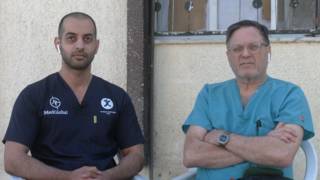
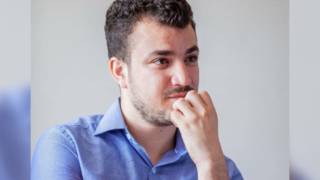
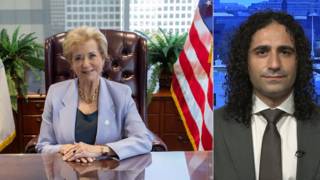
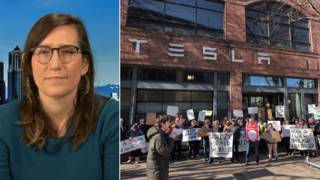
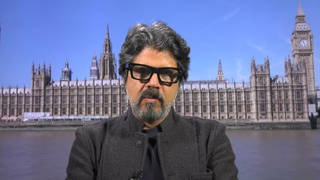
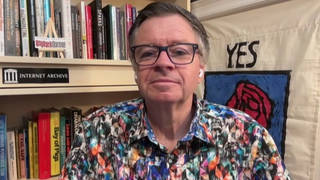
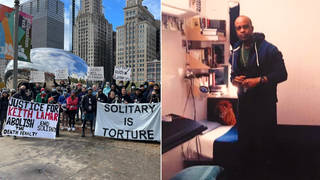


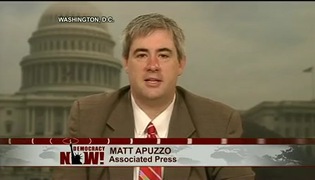
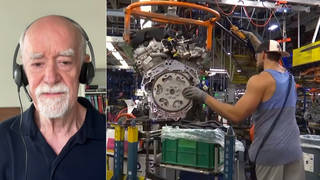
Media Options